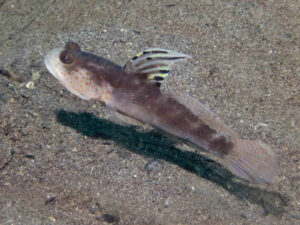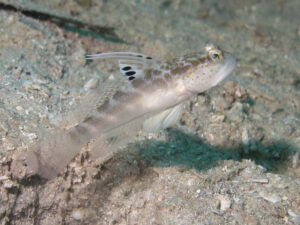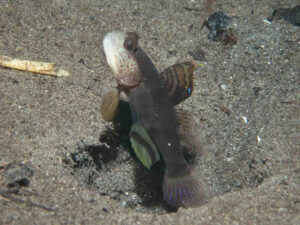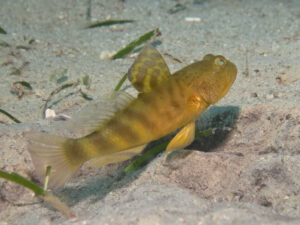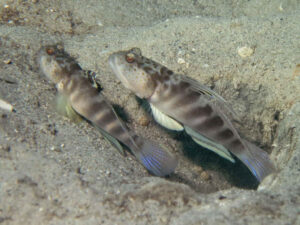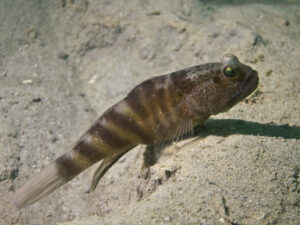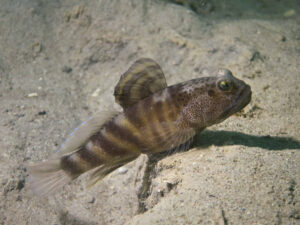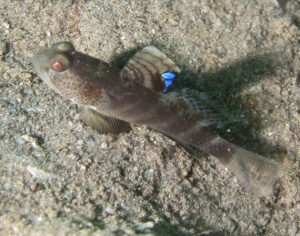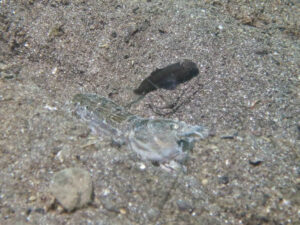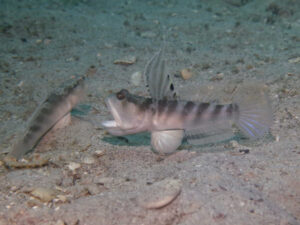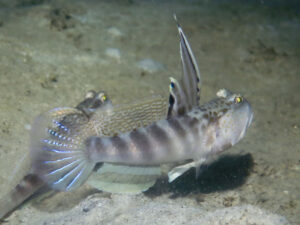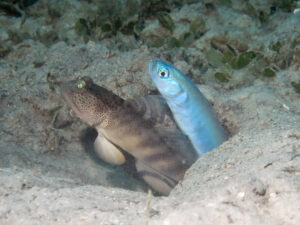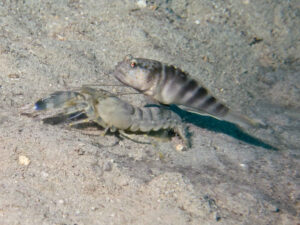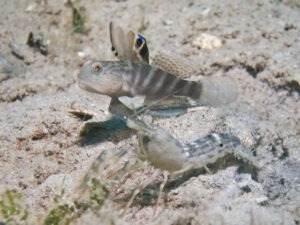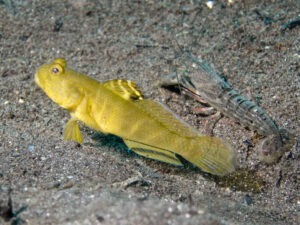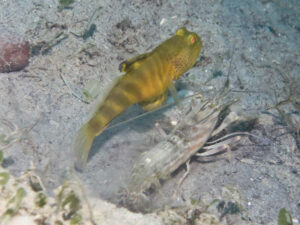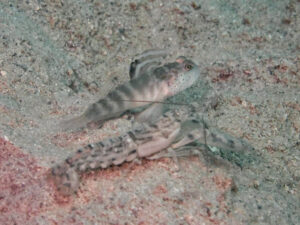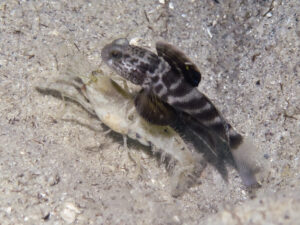Smiling Shrimpgoby
Mahidolia mystacina
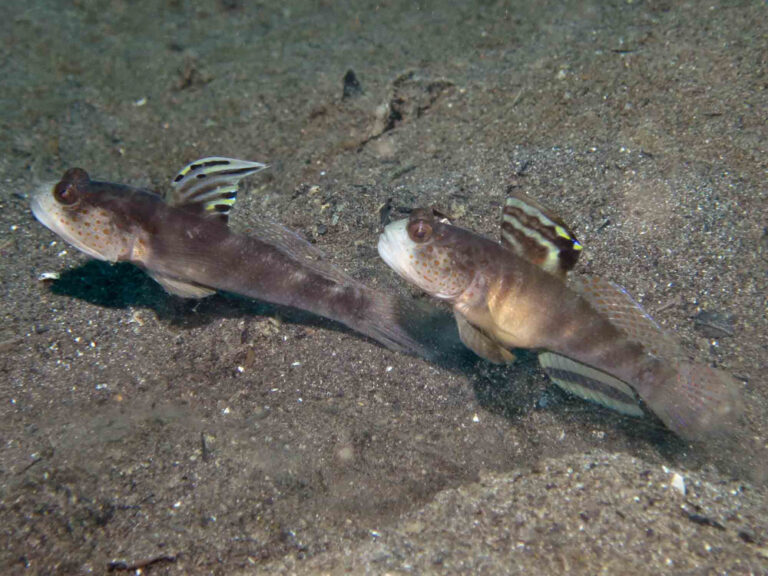
Smiling Shrimpgoby
Mahidolia mystacina
(Valenciennes, 1837)
Description
There is considerable variation in the details of pattern and colour in this species but a general description is still possible.
Body design
This medium-sized goby (up to 8cm) Is usually pale brown with about seven bands on the body. The last four of these are consistently oriented diagonally. The forward three are vertical and line up with the curved brown bands on the female dorsal fin. They are present in the male but do not correspond to any fin markings.
Head design
This varies from a white nose with scattered orange spots on the cheek to an all-brown head densely covered in fine darker brown dots that are also visible on pale areas over the whole body. Juveniles may have face off-white with horizontal lines of dark brown patches running back to the operculum.
Fin design
The first dorsal fin has two distinct forms,
In the male, it is a pale triangle with rays outlined in brown apart from the first which is more yellow and has two black spots near the base. The first two rays are elongated beyond the margin. There are three pale-edged black patches on a brighter blue or yellow background on the posterior part of the fin.
The female fin is rectangular with three horizontal dark-edged bands which become vertical posteriorly to blend with the first three body bars. The background colour is yellow in the all-yellow forms and some brown forms, but is usually light brown. There may be an iridescent blue patch posteriorly. This is more common in juveniles.
In juvenile fish the fins are relatively larger and look atypical
The second dorsal fin is rectangular and decorated between the rays with four lines of alternating pale- and mid-brown patches. A row of patches between the tips of the rays gives it a blue reflective edge.
The pelvic fin is brown. In certain lights, particularly in juveniles, it is shining yellow with a dark horizontal band.
The anal fin matches the body but with a broad brown or translucent line along its length.
The pectoral fin is translucent.
The caudal fin is translucent with darker rays. The upper half is covered in brown spots of the same pattern as the second dorsal fin, and the lower half has reflective blue fin rays.
The golden form has the same markings but with a bright gold background and the bands and other markings are in a darker brownish yellow. The orange facial spots are less contrasty against the yellow background, and the dark rays and spots on the tail are bright yellow.
Taxonomy
Thacker et al (2011) presented a phylogenetic analysis of shrimpgoby nuclear and mitochondrial DNA sequence data. They showed two clades, one composed of Amblyeleotris, Ctenogobiops and Vanderhorstia, and the second included Cryptocentrus, Mahidolia, Tomiyamichthys and Stonogobiops. The interesting thing was that, despite the 13 specimens of Mahidolia mystacina being found at the same locality, Kimbe Bay, and paired with the same shrimps (Alpheus brevicristatus), they split into three widely separated, strongly supported clades.
The 13 sequenced gobies were then reexamined in the light of these findings and although no difference in meristics, scales or fin shape were found, there were colour and design differences. Specifically, one clade showed small light blue spots over the head and dorsum.
These gobies were all juveniles less than 10mm in length. Our observations indicate that the juvenile proportions and patterns may differ from adults.
The authors then examined an extensive series of preserved adult specimens and found no difference in meristics, scale configuration, fin shape or colouration. What this means is that the identification of genetically demonstrated species will only come from the study of live animals and their ecology.
Mahidolia mystacina is certainly very variable. We see variation in dorsal fin design, facial markings and colouration but we have so far not pinned down corresponding behavioural or ecological differences so for the time being we must accept this as a species complex.
Diagnostic features
The posture at the burrow entrance is characteristic. They look hunkered down and grumpy. When elevated the male and female dorsal fins are the most recognisable feature. Juveniles may behave quite differently to adults when under observation. They tend to bounce around the burrow entrance with their disproportionately large fins fully extended, displaying to anyone interested.
Variation
The images have been chosen to highlight the range of variation in this species complex. This is most evident in the face and first dorsal fin design. The differences may ultimately prove to be features that distinguish separate species of the genus Mahidolia.
Brown and yellow forms exist as is also true of Cryptocentrus sericus, Cryptocentrus cinctus and Cryptocentrus fasciatus. Cryptocentrus cinctus unexpectedly grouped with Mahidolia, not Cryptocentrus In Thacker’s study. The two colour morphs grouped in that phylogeny so it might be reasonably be expected that the same would hold for the brown and yellow forms of Mahidolia.
Etymology
mystax Greek – upper lip, inus Latin – belonging to.
Taxonomy
This remains to be resolved.
Natural History
Habitat
In the Solomon Islands, we found these shrimpgobies in a sheltered bay in dense black silt with plentiful vegetable detritus at 5 to 25 metres.
In Australia, we found them at 5 to 10 metres on fine silt on a flat sea bed littered with storm-damaged upturned coral rocks and in a sheltered, rather featureless flat silty sand bay that was said to have been seagrass covered in the past but now has only scattered plants.
When sharing habitat with other shrimpgobies such as Cryptocentrus fasciatus and Myersina nigrivirgata they occupy exclusive territory although the substrate seems the same. We have not observed any correlation between habitat and variation in markings, beyond their being darker on black sand.
Behaviour
They are quite territorial and readily challenge any perceived intruder of their own or other species with flared fins and a widely gaping mouth. The Monofin Dartfish is an exception. Possibly its lightning approach allows no time for response!
Wandering shrimp
We were watching a burrow when all of a sudden shrimp and goby went for a long walk for no apparent reason. When half a metre away from the burrow the goby stopped but the shrimp just kept going, breaking the antenna contact. The shrimp then seemed to become disorientated and fled at increasing speed, in an unusual posture, close to the ground, in the wrong direction, until after 5 metres it shot down a burrow so small it had to force itself in. After a minute a smaller shrimp of the same species was ejected from the burrow and found another one.
The goby stopped and waited for a minute before returning slowly backwards to the original burrow.
We have a photo sequence of males fighting for a female. At one stage both combatants sheltered in the burrow but the fight resumed as soon as they came out. The larger one was dominant and eventually won the contest, after which it joined the female in the burrow.
Diet
They rely on catching small crustaceans and other small creatures observed on the substrate or turned up by the activities of the shrimp. We have also seen Mahidolia chasing a pygmy squid
Distribution
Published distribution
Indo-Pacific East Africa to Micronesia and New Caledonia. S Japan and throughout the East Indian region. (AE). Australia, from Darwin to Cape Ferguson, Qld.
Our records:
Solomon Islands; Gizo, Guadalcanal, Kolombangara and Santa Isabel Islands.
Papua New Guinea; New Britain.
Australia; Fantome Island, Fitzroy Island, Michaelmas Cay, Low Isles.
Associated Shrimp species
Associated Shrimps (seven shrimp)
Blue Nipper Snapping Shrimp, Alpheus cf digitalis
Diagonal Barred Snapping Shrimp, Alpheus rapacida
Mottled Spot-tail Snapping Shrimp, Alpheus species 7
Pigpen Snapping Shrimp, Alpheus rapacida
Red-Whiskered Snapping Shrimp, Alpheus species 11
Tasselled Snapping Shrimp, Alpheus species 14
Titan Snapping Shrimp, Alpheus species 15
They associate with quite a range of snapping shrimp species. What they have in common is that they can all cope with constructing large burrows in fine silt.

